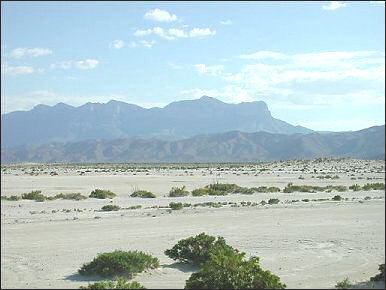

The Chihuahuan Desert is known for its dry lake beds glistening with deposits of salts. One major deposit, at Salt Flats adjacent to the Guadalupe Mountains, triggered the El Paso Salt War. Long considered public property by the Mexican population of the region, trouble arose in the late 1860s as political groups maneuvered for their control. After the first killing in 1870, things calmed somewhat, but there was more to come.
In 1874, Charles Howard filed claim on the flats, enraging the Mexican faction. When he arrested two men who threatened to get salt, rioting broke out, resulting in Howard being held prisoner for 3 days. Subsequently, Howard killed the faction leader.
Arrested by the Texas Rangers, Howard bonded out but then filed
trespass charges against wagoners headed for the salt flats. His presence in San
Elizario to press these charges led to mob action that killed two men, followed by
Howard and two more being executed by a firing squad from Mexico. Troops and American
citizens arriving at San Elizario proceeded to add four more deaths, and the war was
over.

Contributor: Arthur H. Harris, Laboratory for Environmental Biology, Centennial Museum, University of Texas at El Paso.
Desert Diary is a joint production of the Centennial Museum and KTEP National Public Radio at the University of Texas at El Paso.

A small portion of Salt Flats with the Guadalupe Mountains in the background. Lowering of the water table has left the flats without the "bloom" of salts historically produced by capillary action. Photograph by A. H. Harris.